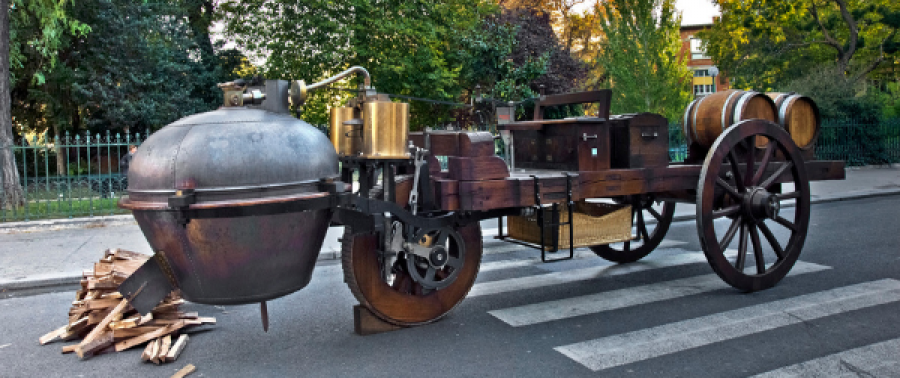2-6 February 2022 - Retromobile, a magnificent time machine

Published: 21/12/2021
Rétromobile has become the international event of the classic car world.
In the eyes of the general public, this exhibition represents a window on the history of locomotion.
The 46th edition of Rétromobile will introduce you to the genesis of the automobile in the most explicit sense of the word "auto - mobile", which comes from the Greek auto (self) and the Latin mobilis (that which moves), i.e. that which moves by its own means.
At Rétromobile, the society "Le Fardier de CUGNOT" will present the first auto-mobile vehicle in live demonstration. The idea of rebuilding a replica of the Fardier de Cugnot came about in 2007. This fantastic project was brought to life thanks to the municipality of Void-Vacon, where Nicolas Joseph Cugnot was born, its mayor André Jannot, Fabrice Génisson, a native of the area and an Arts et Métiers graduate, and a dynamic team of volunteers from the village. This revival was made possible thanks to the involvement of the Arts et Métiers Paris Tech engineering school.
This reconstruction called on the know-how of craftsmen from the region and the Meuse. They performed their trades with passion and worked with their hearts.
Rétromobile, a magnificent time machine ...
Paris Arsenal, 1769:
A great event is being prepared, with King Louis XV and his court making a special trip. The Duke of Choiseul, head of his majesty's government and General Jean-Baptiste Vaquette de Gribeauval, an artillery engineer, are also present. A man is busying himself feverishly around a heavy cart. Unusually, instead of horses, there is a large copper vat in which a wood fire is burning. A crowd of onlookers stands at a distance. Worried stares are fixed on the contraption from which wisps of smoke are beginning to escape, accompanied by the hissing of a bubbling cauldron. The man climbs onto the cart and sits on a wooden bench. He places his hand on a lever, waits a few seconds and with a decisive gesture opens the valve which suddenly releases steam. The machine shakes and leaps forward, spitting out jets of smoke and steam. One of the witnesses to the scene exclaims:
"The fire machine is moving forward! It's moving by itself !"
Two and a half centuries ago, for the first time, the wheels of the first self-propelled machine moved for the first time, thus setting in motion the entire history of the automobile. Its designer, a French military engineer, Nicolas Joseph Cugnot, did not know that he was becoming the first car driver.
Cugnot's project was supported and financed on the decision of the Duke of Choiseul, who was Minister of War under Louis XV, and on the advice of General Gribeauval, a leading artillery specialist. Both believed in mechanising armies and saw in Cugnot's project a solution to the problem of transporting heavy cannons.
1770 was a great success. The Fardier ran at a speed of 4 km/h with a running time of fifteen minutes.
The end of 1770 brought bad news: Cugnot lost his financial support with the forced departure of the Duke of Choiseul and the dismissal of General Gribeauval. Due to a lack of financial means, the Fardier was stored in the warehouses of the Arsenal of Paris. Without new patrons, Nicolas Joseph Cugnot had to stop his work on the development of his Fardier. The futuristic adventure of the first automobile was overtaken and stopped by the history of men as the French revolution began to rumble.
Cugnot's Fardier went through tumultuous times and was miraculously saved and preserved. It is currently on display, since 1801, at the Conservatoire des Arts et Métiers in Paris.
Nicolas Joseph Cugnot was more than a military engineer: he was a visionary with an array of avant-garde ideas.
Regrettably, he will join the ranks of men who were too far ahead of their time.
Despite his setbacks and disappointments, and thanks to the few kilometres he covered at the controls of his Fardier, Nicolas Joseph Cugnot had paved the road to the great adventure of the automobile.... History was in the making...
Historical Fake News
For more than 250 years, all the school history books have been reporting the accident of Cugnot's Fardier, always illustrated with the same engraving showing the Fardier smashing through a wall for lack of brakes. This story was published almost a century after the tests. There is no official record of the accident.
The only writings on the subject date from 1849 and are correspondences due to a quarrel between two museum administrators, all supported in 1867 by the unsubstantiated publications of the scientist Louis Figuier. The live demonstrations will prove the contrary!
It is high time to restore Nicolas Joseph Cugnot's reputation!
For more information please visit https://www.retromobile.com










